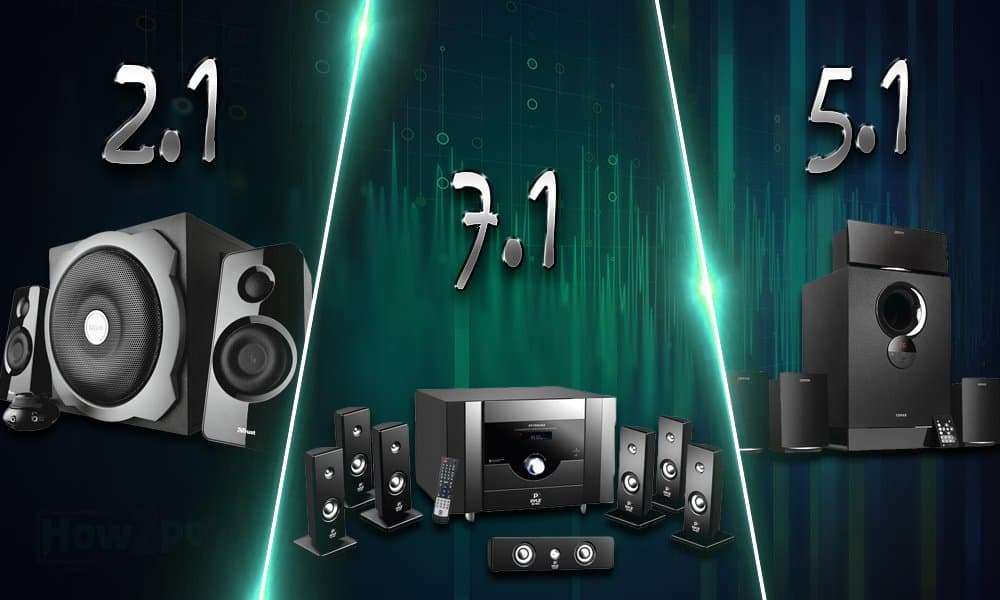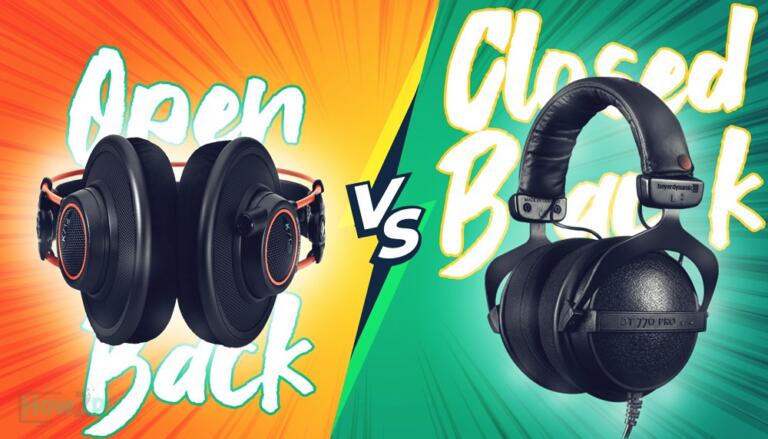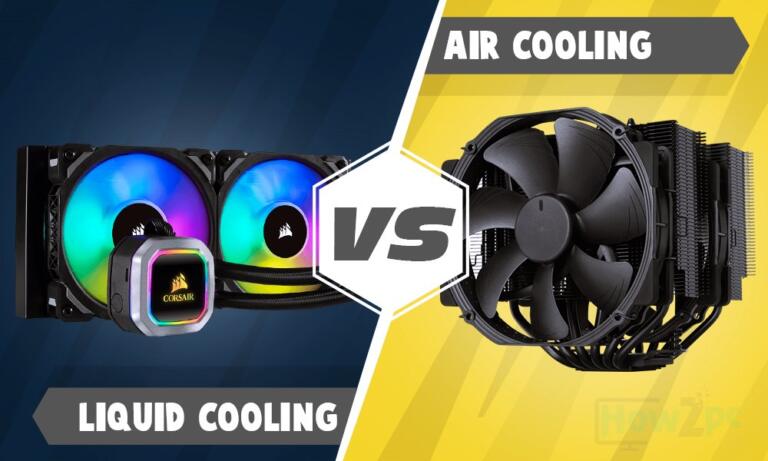If you are in the market for a new surround sound speaker you would have realized by now how confusing it is to filter out the best one due to the confusing naming scheme. There seems to be a general misunderstanding of the various sound channels that speakers are configured in that being 2.1, 5.1, and 7.1.
Therefore in this article, we have taken it upon ourselves to highlight the key differences among them and also pitch 2.1 vs 5.1 vs 7.1 surround sound together to see the pros and cons of each. With that being said let’s dive straight into the key differences between 2.1, 5.1, and 7.1 surround sound.
RELATED:
Computer Speakers Under $100 Recommendations
How to Set Up Speakers on PC
How to Make Computer Speakers Louder?
How to Connect a Bluetooth Speaker to a Computer
Fix: External Computer Speakers Not Working in Windows 10
2.1 vs 5.1 vs 7.1: What’s the Difference?
The numbers here are not just randomly selected they each refer to a certain aspect of the sound. By understanding the use and reference of these numbers we can easily understand the difference between the various sound abbreviation. The first number in this instance 2, 5, or 7 refers to the number of audio channels.
The 2 is used for the left and right audio channels. Any speakers starting with 2 that being either 2.0 or 2.1 have dual left and right channel audio configuration. 5 refers to the left, right, center, and two surrounding channels on each side. These speakers can actually be said to have surround sound due to the inclusion of two surround channels. Likewise, 7 has all the channels of the 5 but includes two extra surround channels. These channels mainly direct audio upwards.
The number after the dot refers to the number of subwoofers included in the overall setup. In or case it is only a single subwoofer as represented by the number “1” after the dot. These are some of the common configurations you will find but these are not only the only ones available out there. The rule is still similar to the first number depicting the number of audio channels and the number after the dot representing the subwoofers present.
One thing to note here is that the channel is not similar to drivers. A single channel can have multiple drivers or just a single one. Therefore in your research, you will find many speakers that have multiple drivers but are dual channels. So keep this in mind because sometimes you will find manufacturers trying to upsell their speakers by mentioning the number of drivers it has.
Benefits and Drawbacks of 2.1 Sound Setup
2.1 sound configuration has been in the industry for quite a while now and many speakers now feature this setup. Due to the widespread use of this sound configuration, it has been integrated into more and more speakers trickling its way into budget speakers as well. So the main advantage of 2.1 sound can be attributed to the fact that good quality speakers with this configuration can be found easily and that too for a bargain price when compared with 5.1 or 7.1 speakers.
One benefit of the dual-channel speaker that is often overlooked is its ability to play music. Music does not necessarily require surround sound and if the music is played on a bad surround sound speaker then the experience can be much sour when compared to listening to music on dual-channel speakers.
Another benefit is the footprint of the overall setup. 2.1 speakers require a pair of satellite speakers and a subwoofer. In a computer setup, this makes more sense especially if you want to put the speakers on a desk. Some manufacturers also have tailor-made speakers for computer setups make utilize the least possible space while not compromising on the sound quality.
The main drawback of this speaker configuration has to be the artificial audio experience. If the audio is directed from only two channels it cannot provide the surround sound experience. Audio in this configuration also lacks the depth and the immersion that the 5.1 or 7.1 configuration provides because in those you get to hear sound in a 3D space which is much closer to how we experience sound in reality.
Benefits and Drawbacks of 5.1 Sound Setup
5.1 sound configuration hits the right sweet spot between 2.1 and 7.1 and provides the best of both worlds. The pricing of 5.1 is great. In terms of price they are priced are far from expensive when compared with 7.1 speakers which makes them a great value considering they also provide a surround sound experience. You have to hear a good surround sound speaker to appreciate the experience and once you do there is no going back to the stereo.
Being able to hear sound from all directions is a much more immersive experience because we in reality also hear 3D sounds. Besides, the surrounding sound another advantage of the 5.1 speakers is that they are not gruesome to install correctly. Most modern speakers have wireless surround channel satellite speakers making the installation process even more convenient. On top of this configuring the speaker in windows is also easy when compared with 7.1 surround speakers.
All in all 5.1 speakers are a jack of all trades in the sense that they provide a similar experience to 7.1 speakers while not being that much more expensive than 2.1 speakers. This is their main benefit and one that compels many people towards them.
The drawback of the 5.1 speaker is linked to its greatest benefit. While 5.1 configuration does allow for surround sound it is not a true surround sound experience because for the ideal surround setup you need 4 extra audio channels. These are only available in 7.1 configuration. Also, for a person who primarily uses speakers for listening to music then 2.1 speakers can be a more compelling option because they are less expensive and provide similar stereo sound.
Benefits and Drawbacks of 7.1 Sound Setup
Right of the bat, one can easily say that the biggest benefit of the 7.1 configuration and one that people buy it for is the true surround sound it provides. As mentioned previously, the 7.1 configuration consists of 4 surround speakers and left, right, and center channel speakers. These provide 3D audio that helps to increase the immersion.
Apart from the sound quality 7.1 speakers also have other benefits mainly being the build quality, the design, and the overall aesthetics of the speaker. Since 7.1 configuration is used mainly in high-end speakers these also have top-notch build quality along with a pleasing design. Still, people do not buy 7.1 speakers for build, design, features but rather for the surround sound they provide and this is where the drawback of these start to trickle in.
While the 7.1 surround sound configuration is great but getting all the speakers to work correctly is a bit of a chore if placing them in the ideal position already wasn’t. Also, 7.1 surround sound technology is relatively new so it is not compatible with older audio encoding formats therefore rendering it useless for some applications.
YOU MAY ALSO LIKE:
Bookshelf Speakers Under $200 Recommendations
Bookshelf vs Floorstanding Speakers
Soundbar vs Bookshelf Speakers
Bookshelf Speakers vs Studio Monitors
Everything You Need to Know Bookshelf Speakers
Which One Should You Buy?
There is no concrete answer to this because all the configurations whether it may be 2.1, 5.1, or 7.1. They all have their own place and purpose and are useful in certain scenarios. Having the wrong configuration can a bit detrimental and can also lead to an inferior experience. Speakers also have to be integrated into different setups and people also have different needs and wants for their speaker therefore providing a concrete answer is not possible because it is entirely subjective. Therefore, choose the one which complements your room and set up the best.








